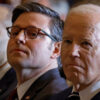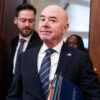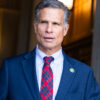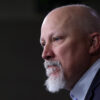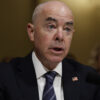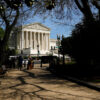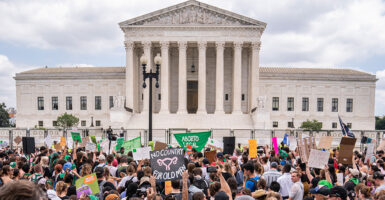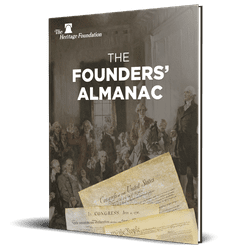Few times in American history has the Supreme Court received more attention than in the past two months.
What will history say about this past Supreme Court term? Will we ever know who leaked the draft majority opinion in the Dobbs case? And how is new Justice Ketanji Brown Jackson going to change the Supreme Court moving forward?
Heritage Foundation legal experts Zack Smith and GianCarlo Canaparo join “The Daily Signal Podcast” to answer these questions and to preview cases the justices will hear in the fall.
Also on today’s show, we cover these stories:
- The Senate Judiciary Committee hosts a hearing about the legal landscape in the country following the Supreme Court’s decision to overturn Roe v. Wade.
- First lady Jill Biden apologizes for drawing a comparison between Hispanic Americans and tacos.
- A leftist pro-abortion group offers to pay a cash bounty for information on the location of conservative justices when they are out in public.
Listen to the podcast below or read the lightly edited transcript:
Virginia Allen: I am so pleased to welcome back to the show today Heritage Foundation legal experts and hosts of the “SCOTUS 101” podcast Zack Smith and GianCarlo Canaparo. Gentlemen, thank you so much for being here.
GianCarlo Canaparo: Thanks for having us.
Zack Smith: Thanks, Virginia.
Allen: So, the Supreme Court has just finished its term. And I’m no legal expert, so correct me if I’m wrong, but this Supreme Court term felt pretty historic. How would you-all describe this past term?
Canaparo: Oh, it was a snooze fest as far as I’m concerned. Nothing interesting happened at all.
Smith: I know. I didn’t think we were going to have enough information to cover, GianCarlo.
Canaparo: No, no, no. Nothing at all. So—
Allen: Nice and quiet.
Canaparo: No, it was in fact an absolutely historic term capped, of course, by, I mean the greatest victory of the conservative legal movement that’s been going on. This fight has been happening for 50 years, to overrule Roe v. Wade, which was, from a legal perspective, a constitutional abomination.
The Supreme Court said, “We don’t care that there’s nothing in the Constitution here. We want this outcome and we’re going to impose it.” And that was a huge blow to our constitutional system, was a huge blow to American democracy. And it is great that we finally fixed that mistake.
Smith: And I think it’s interesting, Virginia, because each term there’s typically one, maybe two cases where I think you look at and you say, “Wow, students will be reading this case in their first year law classes, 10, 15 years from now.” But it seems like this term, there were many, many of those cases, not only the Dobbs case that GC was talking about. But there was also an important Second Amendment case, also several important religious liberty cases. And so this really was a blockbuster term in the history of the court.
Canaparo: And don’t forget the sleeper issues were some of the administrative law cases, which we can talk about in some detail. But those, they don’t tend to get noticed as much because they don’t implicate sort of the high-profile political issues of the day. But in many ways, those are actually some of the most important cases the Supreme Court decided this term.
Smith: Do you mean to tell me notice and comment rule-making isn’t the sexiest issue the court addresses?
Allen: I was going to say, I haven’t seen many headlines talking about that. For some reason it doesn’t catch the public’s interest as much.
Canaparo: Well, apparently I’m the outlier there.
Allen: But if you would share briefly, what is the significance of some of those cases?
Canaparo: Yeah. So let me, we’ll start from the very beginning, right, with the Constitution. The Constitution, its great genius was not only that it was written law—because, you know, Britain had a constitution, it was not written; other countries did not have written constitutions—but also the idea that power is separated because you can’t protect freedom as long as the power over that freedom is in one person or one institution’s hand. So they cut out power.
Congress gets to make the laws. The president gets to enforce the laws. The judiciary gets to interpret them.
Well, ever since Woodrow Wilson and then [Franklin D. Roosevelt] came along, we have consolidated power in the administrative state. So these executive branch agencies, the alphabet soup of Washington, have the power to essentially write laws.
Congress has said, “Look, we don’t want to do our job. You do it for us.” And they have the power to enforce those laws. And sometimes they have the power to hear cases and trials about those laws.
So you’ve got an enormous amount of power conglomerated in the administrative state and like any sort of power-hoarding body, it grows, it expands its own power. And for many years the judiciary has been OK with that under a doctrine called Chevron and Auer. These are deference doctrines the court has said, “Look, as long as the agency is doing something, that’s sort of reasonable. We’re going to let them just do whatever they want.”
And that has been a big problem for a lot of reasons. Not only is it sort of, as a matter of first principles, wrong on the Constitution, but you get a lot of very progressive types who stock administrative agencies because they tend to be the kinds who think that the government is the salvation of the people and you have just seen the administrative state run away with itself.
And this term, we got a number of cases where the Supreme Court put the breaks on that in a pretty big way and said, “Look, no, the legislative power belongs to the people and their representatives in Congress and the executive agencies need to stop this runaway power grab.”
Allen: That’s encouraging to see there was actually a little bit of a line in the sand drawn, right?
Zack, I want to ask you, I think a question that I have repeatedly heard individuals ask over the past month, as we look back at some of these significant cases and of course, with the Dobbs case being one of the most significant of the past term, is, are we ever going to learn who leaked [Justice Samuel] Alito’s opinion draft opinion of the Dobbs case?
And if so, is that going to be like 10 years down the road after everyone’s kind of forgotten?
Smith: Well, I certainly hope we learn who the leaker is because, we’ve talked about it before, it was such a breach of decorum for the core. It really hampered the ability of the justices and the clerks, their ability to freely exchange information, which is so vital to their ability to do their jobs and decide cases fairly and impartially. And so I think it’s important that we find out who the leaker is.
Unfortunately, we haven’t heard a lot of information about the investigation. We know that the chief justice put the marshal of the Supreme Court in charge of the investigation and we’ve heard drips and drafts of information coming out of the court since the leak about what processes are being put in place to find out who leaked the opinion and what’s being done to hopefully prevent that from happening again in the future.
Several months ago we heard that the marshal of the court was asking law clerks for their cellphones, maybe some call record information. We don’t know what form that request took. We don’t know if it was mandatory: “Do it or you’ll be fired.” We don’t know if it was part of a criminal process. We don’t know if it was something as simple as a simple request: “Do you mind sharing your call logs with us?”
And that’s important because depending on the form of the ask, that has different legal consequences, different legal ramifications.
And so there’s a lot we really don’t know, but hopefully now that the court’s term is over the justices have done the hard work of getting their final opinions out the door that really the focus can be on the investigation, finding out who leaked the opinion, and really focusing on how to prevent this from happening again in the future.
Allen: GianCarlo, I know that a lot of people brought up, well, why don’t they just have everyone who works within the Supreme Court building sign something saying, “I did not leak”? Why hasn’t that happened? Would that be a good strategy to make people actually put on paper and be forced to either, obviously, tell the truth or have to lie?
Canaparo: Well, in terms of strategy, what it could do is, if you ended up finding the leaker, give you an avenue to prosecute them for lying to law enforcement. It’s not clear to me. Zack might—Zack was a former federal prosecutor, so he’ll have some better sense of how investigations go.
Smith: Well, you’re certainly on the right track, GC. [The Heritage Foundation’s] John Malcolm and I actually wrote an article about this on The Daily Signal right after the leak happened. Unfortunately, it’s not clear that there’s a criminal law directly on point that would apply to this situation if someone who worked for the court actually leaked the draft opinion.
Allen: I see.
Smith: There’s a couple of criminal laws that might apply. But again, there may be some issues with that.
What you’re talking about, Virginia, by having someone sign, essentially, a declaration under penalty of perjury that they did not leak—well, if someone refuses to sign it, that’s a great place to start the investigation, or if someone signs it and they in fact lie saying they didn’t leak anything, when in fact they did, well, that is a criminal violation. It’s a 1001 violation.
We’ve heard about it a lot in the news lately related to the Russia collusion investigation and others, but GC was certainly right, that would provide a much clearer pathway to a criminal prosecution if someone lied on that declaration.
Allen: It’ll be fascinating to see how that continues to roll out. And hopefully we will get some news on that.
Now, I want to ask you-all a little bit about this particular Supreme Court as a whole. We’re hearing a lot of statements in the media, a lot of people making claims about this Supreme Court being much more conservative, maybe in their political views, than other Supreme Courts in past history.
Do you-all think that is a fair assessment? How does the Supreme Court compare to some of the past sitting courts we’ve seen?
Canaparo: So yeah, let me start pushing back on the narrative that what the court does is inherently political. The court is conservative in a small “C” way. But what that really highlights is that there’s two aspects to conservatism.
There is conservatism with a big “C,” where you’re striving for political outcomes, which are conservative. But conservatives have done a good job of developing a method of doing what judges do that is conservative in a small “C” way, but not reaching for politically conservative outcomes.
And what that is, it’s called originalism, when we’re talking about the Constitution or textualism, when we’re talking about statutes. And the principle’s simple. It’s that judges have the power to interpret the law, not the power to make law. And so they need to be constrained by what the law actually says. The meaning of the words on the page.
And this is typically a small “C” conservative position, although there are a lot of very thoughtful, smart, liberal law professors out there, some of the best ones, some of the smartest ones, even on the left, who agree that originalism and textualism is the way to go.
But that process of limiting judges to the text of statutes is often going to produce conservative big “C” political outcomes, simply because it means that the legal process isn’t going to lend itself to new and liberal expressions of the law that don’t preexist them. Right?
So if you want to change the law and you are a liberal and you want a judge to change the law for you, rather than the legislature to rewrite a law, a judge isn’t going to have that power if they are a textualist judge.
So it’s going to lend to small “C” conservative outcomes oftentimes, but not always, but it is a mistake to say that this is political conservatism at work. What it is, it’s judges being restrained. It is judges saying, “The text of a statute, which may have been set down many years ago when social mores were different, for instance, controls until Congress or the people change it themselves.”
So in that way, we have seen a shift. This is really the first time since originalism really took off as an idea and a theory in the ’80s with Ed Meese and [Robert] Bork and Justice [Antonin] Scalia, this is the first time we have had a majority of the court that is really committed to that idea. And that is really heartening.
There will be growing pains as some of the really aggressive activist decisions of the past are reversed because the court used to think that the judges were philosopher kings who could do what they wanted. But so, we’re going to have some growing pains as we correct those mistakes. But that, in the long run, is a very good thing.
Allen: So now we have Ketanji Brown Jackson. She’s been sworn in as Justice Ketanji Brown Jackson coming onto the court. Zack, I want to start with you. How do you think that she’s going to affect the sitting court?
Smith: Well, I don’t think she’ll change the ideological makeup of the court. That was part of the issues surrounding the appointment of Justice Amy Coney Barrett and other justices. They shifted the ideological makeup, going from what was in the past a judge or a justice who was adhering to a living constitutionalist approach, basically saying they were free to update the law as they saw fit to a justice who was adhering to that originalist textualist approach that GC was talking about.
Now, Judge Ketanji Brown Jackson, now Justice Jackson, during her confirmation hearing, I thought it was very interesting because she echoed to some extent some of those originalist textualist talking points that many of the other justices who are currently on the court have also been publicly speaking about for many years now.
Now, given her judicial record, I doubt she is a committed originalist or textualist. I certainly hope she sticks to many of the talking points she raised in her confirmation hearing, but based on her past record, I’m skeptical that she will.
And so at the end of the day, I don’t think her elevation to the court will change the ideological composition. And I suspect she will be a member of the court’s solid liberal block.
Canaparo: Yeah. Let me weigh in on one point, that she’s replacing Justice [Stephen] Breyer. Justice Breyer is a reliable vote on the liberal wing of the court, but Justice Breyer has also over time demonstrated that he is very capable of building coalitions on the court.
He is, as many of the former clerks or justices will tell you, he’s one of the most amiable guys on the court after maybe Justice [Clarence] Thomas, who is just the happiest and friendliest guy any of them have ever met.
But that meant that a lot of times you would see Justice Breyer would write majority opinions, oftentimes in very high-profile cases, where it seems that he was able to unite a coalition around him.
By contrast, compare him to Justice Sonia Sotomayor, who does not have that ability. She is very much sort of—oftentimes she’s too far out on the left, even for Justice [Elena] Kagan and Breyer to join her. She writes alone very often. She has not demonstrated the ability to build coalitions. And Justice Kagan does it sometimes, but not to Justice Breyer’s extent.
So it’ll be interesting with Justice Breyer gone. Will the left the three liberals on the court, will they sort of retreat farther left and be out on their own or will one of them step up and be a coalition-builder like Breyer was?
Smith: And the other interesting aspect to that is, a lot of Judge Jackson’s time was spent on the district court. She was a trial judge. A trial judge sits alone and is really the king or queen of their realm. Basically, what they say in the courtroom goes.
She was only on the D.C. Circuit Court of Appeals and Intermediate Appellate Court for a very brief period of time. And so going from that situation where, essentially, she is in charge of the show, she is the director, essentially calling the shots to having to work in that more collegial environment, build the coalitions to reach a preferred outcome, I imagine that’s a difficult transition for many judges to make.
And so I would suspect there may also be a learning curve for her as she adjusts to that new dynamic.
Allen: That makes sense. Well, give us a little bit of a preview of what’s to come. Already the Supreme Court has announced some of the cases that they’re going to hear in their next session. What are the cases that you-all are watching and when do the justices return to the court?
Smith: There are two big election-related cases that I think are worth keeping on everyone’s radar. That’s Milligan v. Merrill and then Moore v. Harper.
Milligan deals with redistricting issues coming out of Alabama, it’s essentially the court is being asked to review what standard applies when states try to draw majority-minority districts. And so there’s been a lot of uncertainty in that area, a lot of litigation surrounding it. And so that’ll be a very interesting case to watch in the fall.
Now, the other case, the Moore case out of North Carolina, involves something called the “independent state legislature doctrine.” The Constitution says that state legislatures are free to regulate the time, place, and manner of elections. Congress can, in certain circumstances, step in and override those decisions. But traditionally, states and state legislatures in particular have set those parameters for elections.
What we saw in the last election, particularly in 2020, was that other state entities—either executive branch entities, the governor or executive branch agencies, or the courts—were stepping in, changing the rules and regulations that the state legislatures had put in place.
And so the court’s being asked to decide, essentially, whether the state legislatures do indeed have the predominant authority within a state to set those regulations. And so this will be a very important election-related case, particularly as the 2024 presidential election is increasingly right around the corner.
Allen: GianCarlo, anything that you’re watching?
Canaparo: Yes. We have a really big case, the Harvard and UNC race admissions case. So, as you probably recall, Harvard College and the University of North Carolina both use race in admissions, and they’re not allowed under older Supreme Court precedents to create race quotas explicitly, but they have essentially done that by massaging other race factors to diminish the amount of Asian students they have so that they can give those places to black and Hispanic students.
So they have used race, they’re engaging in race discrimination to reach what they believe is an equitable racial balance in their student bodies.
And so those cases are before the Supreme Court and I’m hopeful, at least, that the Supreme Court says, “Enough with the race-based nonsense. We’re not going to do that anymore.” And there’s some reason to believe that they will, there’s some voices, the chief justice, Justice Clarence Thomas have made very clear for a long time that they’re not OK with racial discrimination in schools or anywhere else for that matter.
So that’s a big one that I’m watching.
We have another one, a religious liberty case called 303 Creative—you might recall from a few years ago, there was the Masterpiece Cakeshop case. And the question there was whether a man who was a cake artist, if you will, could be punished for not making a custom wedding cake for a gay wedding. He was a devout Christian.
And that case, the court didn’t ultimately reach the underlying issue because the state had exhibited so much hostility to him in its process that they said, “Go back and do it again.” So this case raises the issue squarely. This is a graphic artist, and whether she can be forced to make website designs and things for a gay wedding, for which she believes is not appropriate. So that’ll be a square facing of that issue.
Allen: A little more straightforward. And what is the timeline? How long are the justices on their break or summer break, if you will, before they come back to the court?
Canaparo: They will come back to the court to start hearing oral arguments again in October.
Allen: OK.
Canaparo: They do work. So, they tend to be on vacation, they travel a lot over the summer, but they are working. And what they’re doing right now is deciding which cases they’re going to hear next term.
Smith: And typically, right before the term starts, the justices will hold something called the long conference where they essentially review all of the cert petitions, the request for them to review cases that have come up over the summer months. And typically, before they start hearing oral argument, [they] will issue kind of a slate of decision saying which additional cases they’ll hear for the term and which ones they’re declining to hear.
Allen: OK. Great. Thank you-all so much. I want to give you-all a second, though, because you-all host a great podcast called “SCOTUS 101” that if folks listening want more of this, want to hear what is happening in the court, they need to check out your podcast. So share with us a little bit about what you-all do.
Canaparo: Yeah, sure. We follow the Supreme Court every week that the Supreme Court is in session and hearing cases or issuing oral arguments or issuing opinions. We will have a podcast where we digest all of it, unpack it for you, and give you a little bit of the Supreme Court gossip going on.
Smith: That’s right. If people can stand listening to more of GC, we do cover Supreme Court gossip. We do a little trivia. And then we typically also have an interview each week, either with a judge or a lawyer or a practitioner. And I think we get some interesting conversations going during the podcast.
Canaparo: That’s right. Trivia is my favorite part of the show. Yeah. Zack is slightly less enthusiastic, which, of course, means that I like it all the more.
Smith: I know.
Allen: More trivia, nothing wrong with that.
Smith: We’ll have to talk about that.
Allen: Yeah. Sorry, Zack. I certainly encourage our listeners to check out “SCOTUS 101” on Apple Podcasts, Spotify, wherever you like to listen. And if you want to read more about Zack Smith or Giancarlo Canaparo’s work, you can read it at heritage.org, search for their names there. But thank you, gentlemen, so much for your time today. We appreciate it.
Smith: Of course.
Canaparo: Thanks for having us.
Have an opinion about this article? To sound off, please email letters@DailySignal.com and we’ll consider publishing your edited remarks in our regular “We Hear You” feature. Remember to include the url or headline of the article plus your name and town and/or state.

